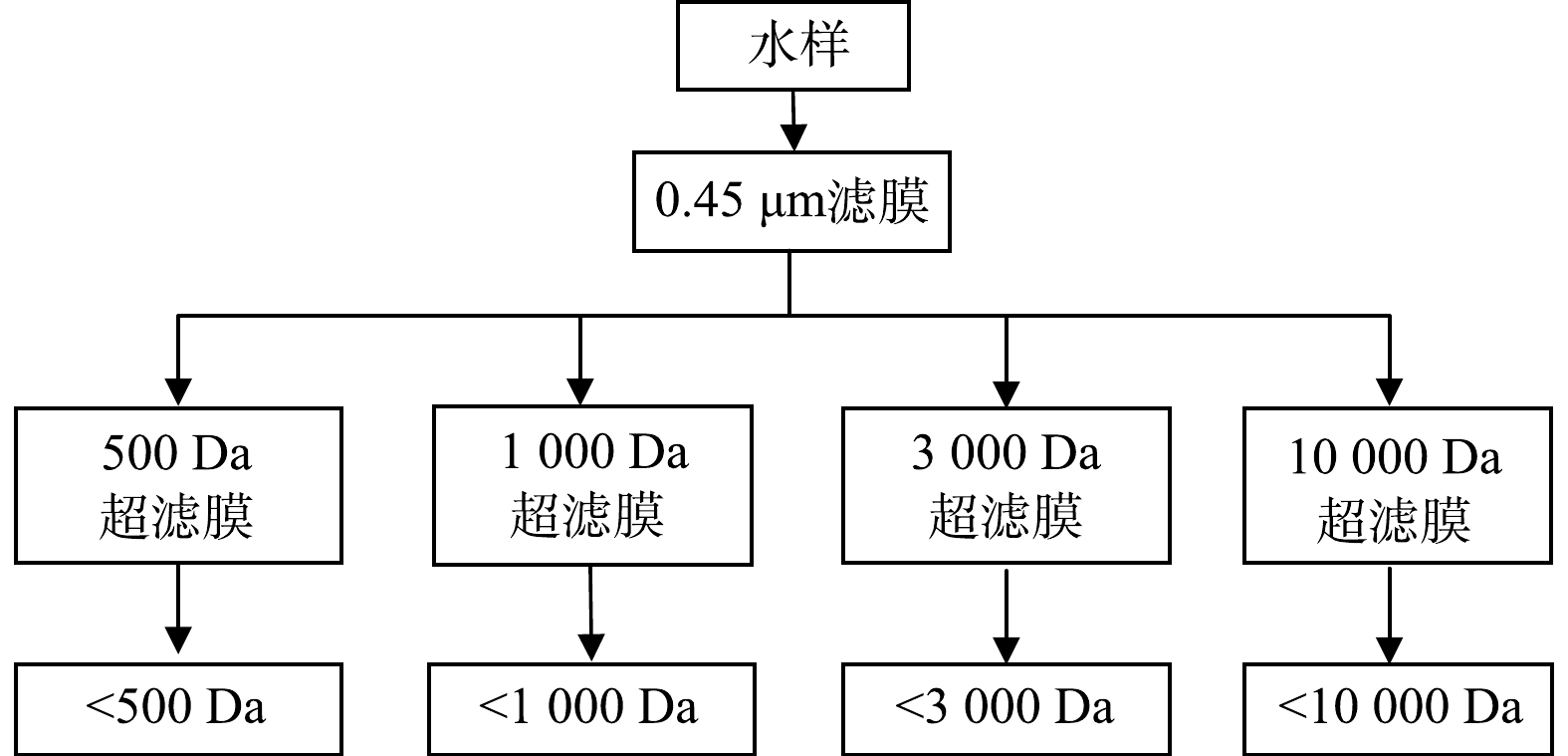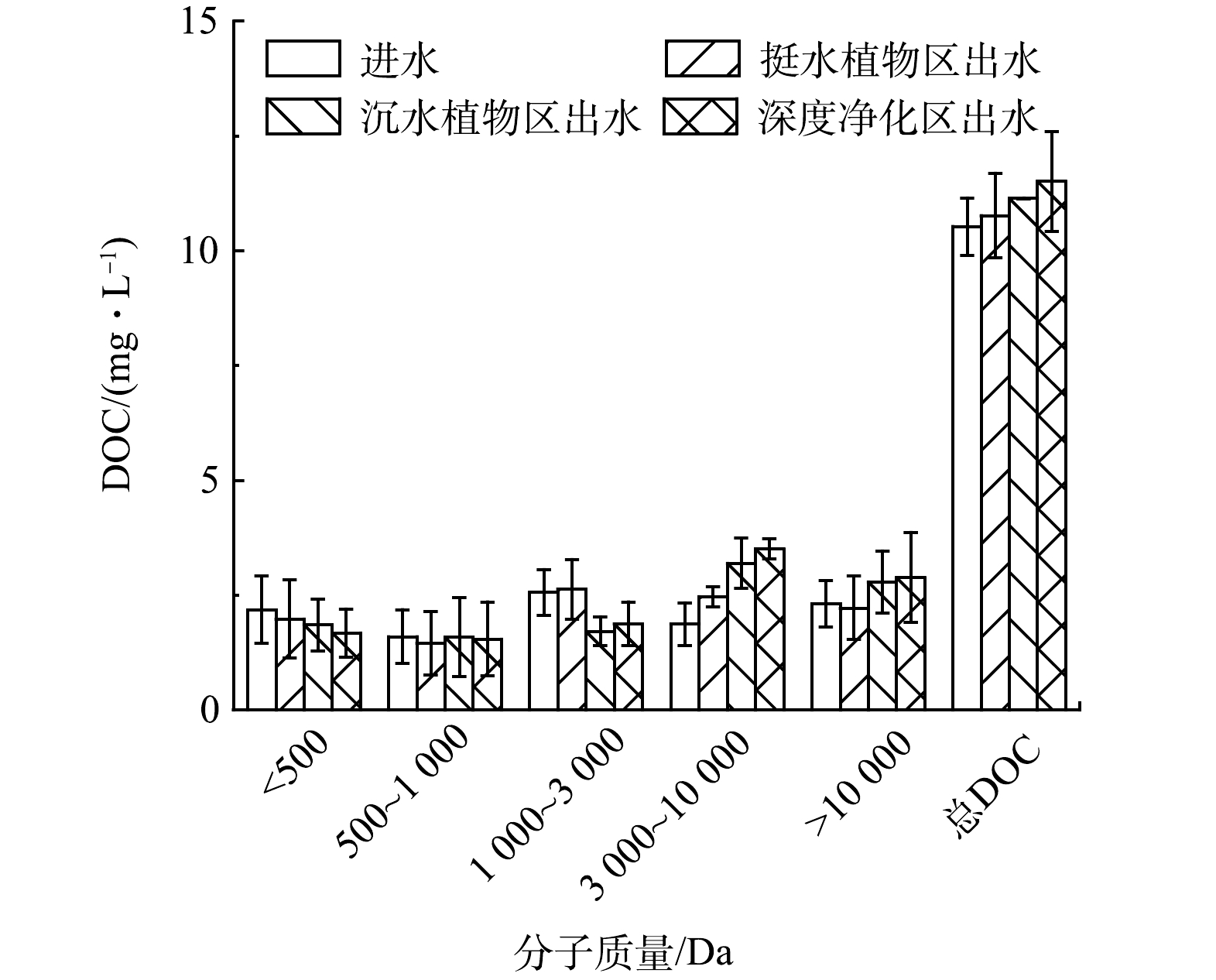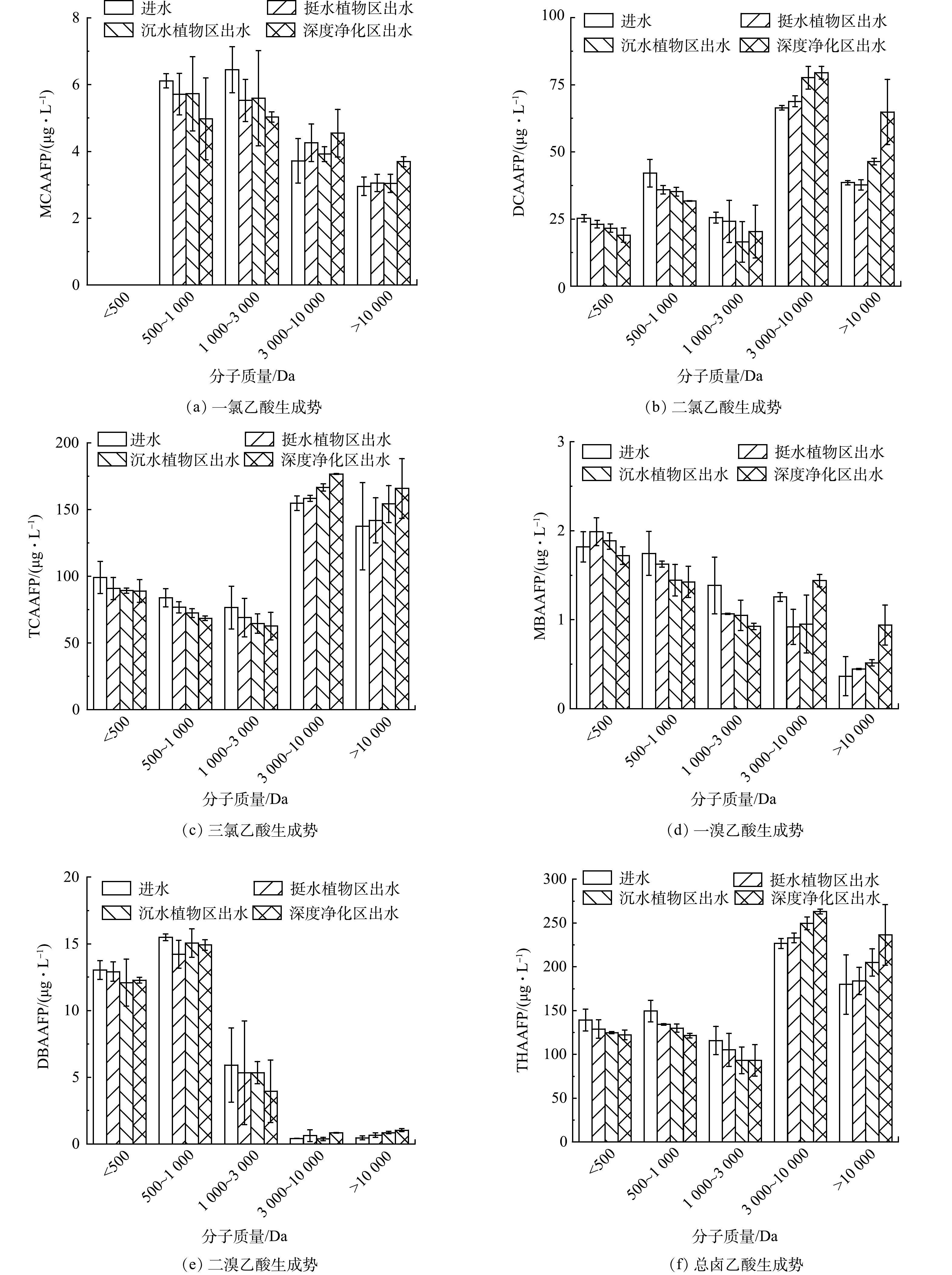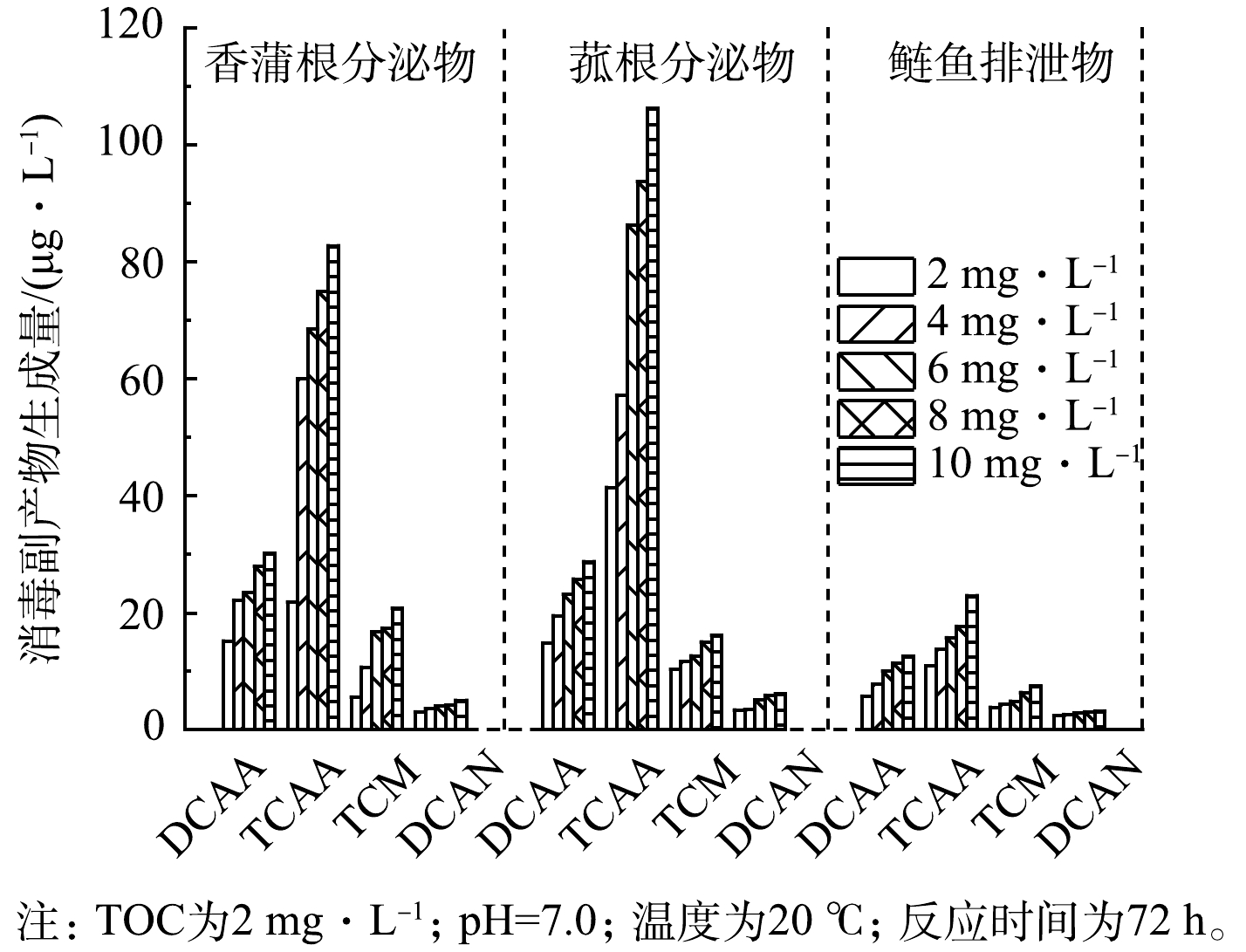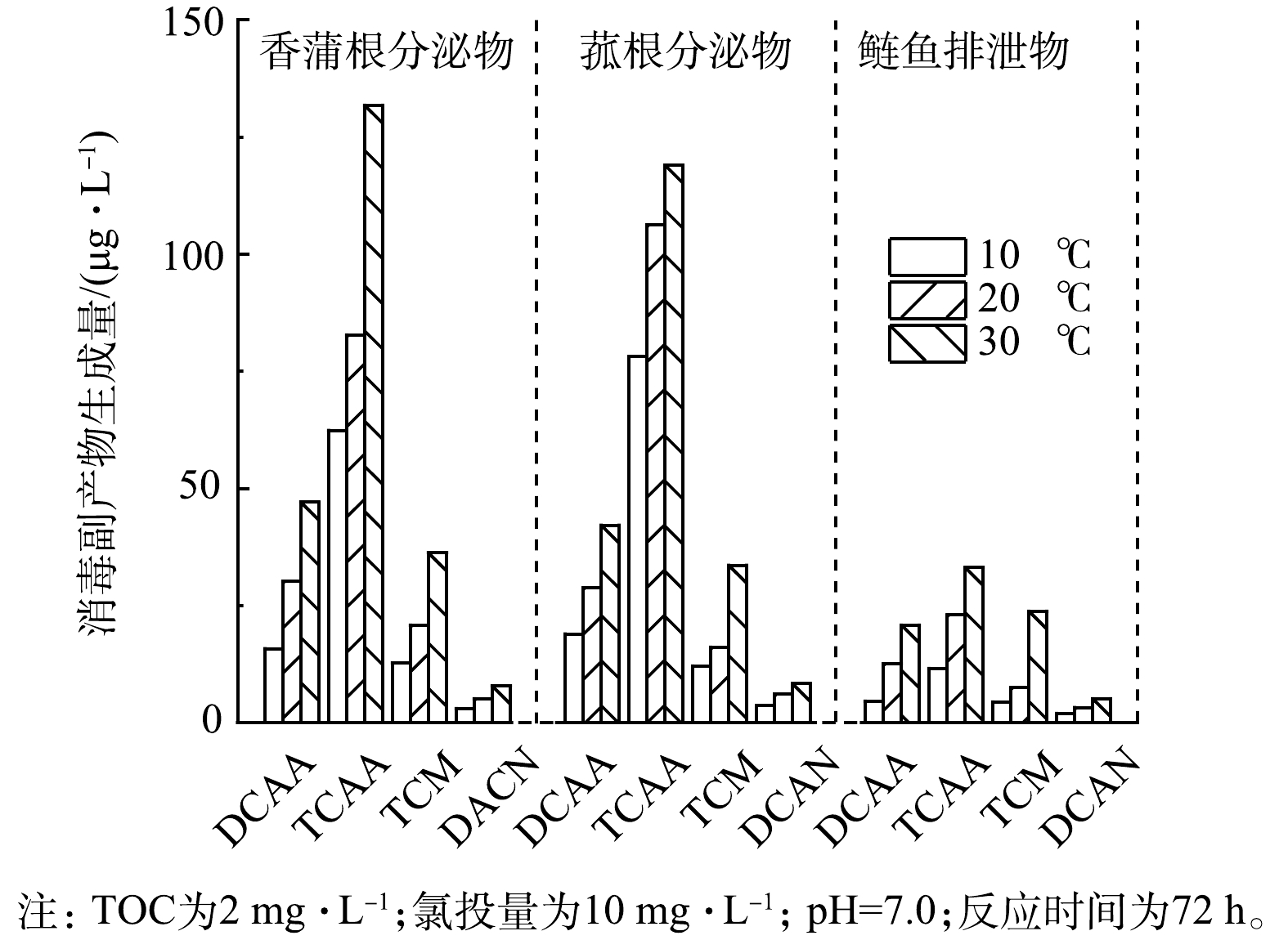-
水源地生态工程是将人工湿地与水库耦合形成的一种新的人工生态工程系统,被认为是一种具有改善原水水质的有效措施,用以改善微污染河流饮用水源的水质并具有应急存储能力[1]。人工湿地能够有效去除饮用水源中的多种污染物(如氮、磷)[2],然而,人工湿地本身也可能是溶解性有机物(dissolved organic matter, DOM)的来源[3]。通过人工湿地处理后DOM的增加可能来源于3个方面:水生植物的生长、代谢和分解;藻类胞外有机物的释放和溶解;湿地中沉积物的释放[4]。这些DOM通过氯消毒可能形成消毒副产物(disinfection by-products, DBPs)[5],如三卤甲烷(trihalomethanes, THMs)和卤代乙酸(haloacetic acids, HAAs)。PELLERIN等[6]研究了香蒲植物浸出液生物降解后的消毒副产物生成,结果表明,浸出液经过生物降解后三卤甲烷生成势(the trihalomethane formation potential, THMFP)与萨克拉门托-圣华金三角洲的地表水相当,表明维管植物衍生的DOM在地表水中是THMs的前体物。由于前体物的大小会影响DBPs的形成,DOM的分子质量(molecular weight, MW)是饮用水处理过程中的重要特征[7]。然而,在单个MW馏分的DBPs形成方面没有观察到一致的趋势[8]。因此,探究DOM分子质量与DBPs的形成关系,有利于更好地控制DBPs的生成,保障饮用水安全。
近年来,已有大量关于藻类衍生的DOM生成消毒副产物的研究[9-10],藻类释放的胞外和胞内有机物会导致水中的溶解性有机氮(dissolved organic nitrogen, DON)质量浓度升高,被认为是含氮消毒副产物(N-DBPs)前体物的来源。然而湿地中水生动植物的代谢物引入的DOM作为DBPs的前体物的研究不足。本研究模拟盐龙湖生态工程构建实验装置,研究水源地生态工程对水源水水质的影响,利用分子质量分级研究实验装置处理前后微污染原水中DBPs前体物的性质。同时,选择系统中的香蒲根分泌物、菰根分泌物和鲢鱼排泄物这3种水生生物代谢物作为研究对象,探究了氯化消毒反应条件对3种水生生物代谢物消毒副产物生成量的影响,为保障饮用水安全提供参考。
-
模拟盐城市盐龙湖水源地生态水库,构建如图1所示的实验装置。装置由挺水植物区、沉水植物区以及深度净化区3个单元组成,各单元参数如表1所示。在深度净化区引入鲢鱼和鳙鱼,鲢鱼投放密度为20 g·m−3,鳙鱼投放密度为10 g·m−3。原水由泵提升至高位水箱,然后依次通过挺水植物区、沉水植物区以及深度净化区。实验用水取自蟒蛇河取水口,水质pH为7.48~7.56,氨氮为0.43~0.87 mg·L−1,总磷为0.06~0.12 mg·L−1,总氮为1.78~2.29 mg·L−1[11]。
-
1)实验装置水样的采集。沿实验装置水流方向依次设置4个取样点,如图1所示,分别位于挺水植物区进水口、挺水植物区出水口、沉水植物区出水口和深度净化区出水口,经0.45 μm滤膜过滤后及时测定或置于4 ℃冰箱冷藏保存不超过24 h。
2)水生生物代谢物的制备。提取实验装置中长势良好的香蒲和菰植株,用超纯水洗涤干净植物根系后放入1 000 mL的烧杯中,在烧杯中加入超纯水没过植物根系,水面以下避光培养24 h,经0.45 μm滤膜过滤,并稀释TOC为2 mg·L−1,得到相应的根分泌物制备液。取实验装置中的健康鲢鱼置于超纯水中,取其排泄物,加入超纯水后置于旋涡混合仪上振荡2 min后,经0.45 μm滤膜过滤,并稀释至TOC为2 mg·L−1,得到鲢鱼排泄物制备液。
3)有机物分级分离。根据研究[12]方法,超滤杯分级步骤如图2所示。在分级前,依次用0.5 mol·L−1的盐酸、0.5 mol·L−1的氢氧化钠清洗滤膜30 min,反复清洗3次,最后用超纯水清洗,清洗后保存在超纯水中。选用不同分子质量规格的超滤膜(10 000、3 000 、1 000、500 Da)对过滤液过滤,将超滤杯装置(MSC300,上海摩速)置于磁力搅拌器上,调节至合适的转速,将超滤杯装置与氮气瓶连接,调节氮气瓶压力在0.1~0.22 MPa,每级分子质量均先过滤100 mL超纯水再过滤水样,弃去50 mL水样初滤液。以平行法进行过滤,各分子质量区间内有机物含量用差减法求得。
-
参照文献[13]方法,取100 mL水样于250 mL锥形瓶中,向水样中加入2 mL pH=7的0.01 mol·L−1磷酸盐缓冲溶液后,加入0.5 mL有效氯质量浓度为4 000 mg·L−1的次氯酸钠溶液使水样中的有效氯质量浓度为20 mg·L−1,在(20±1) ℃条件下避光反应72 h,若反应后使用余氯测定仪(PCⅡ,HACH)测定余氯质量浓度在3~5 mg·L−1,加入0.5 g抗坏血酸终止反应。上述过程中的加氯量仅适用于从装置中采集的原水样,对于实验中的其余水样,加氯量以最终控制余氯在3~5 mg·L−1为准。
对于水生生物代谢物制备液,其TOC为2 mg·L−1,取100 mL水样于250 mL锥形瓶中,加入2 mL pH=7的0.01 mol·L−1磷酸盐缓冲溶液,氯化反应结束后加入0.5 g抗坏血酸终止反应。氯化反应的基本条件为:加氯量10 mg·L−1,pH=7.0,在(20±1) ℃条件下避光反应72 h。在反应基本条件的前提下,每次改变1个变量进行氯化消毒反应,考察的变量分别为加氯量(2、4、6、8、10 mg·L−1,以Cl2计)、温度(10、20、30 ℃)、pH(5、6、7、8、9)。
-
1)卤乙酸的测定。参照文献[14]方法,使用螺口带聚四氟乙烯瓶盖的样品瓶,取20 mL水样加入1 mL浓硫酸和8 g无水硫酸钠,振荡至无水硫酸钠完全溶解,加入4 mL含内标(300 μg·L−1 1,2-二溴丙烷)甲基叔丁基醚振荡萃取,静置30 min后取上层有机相2 mL至另一样品瓶中,加入2 mL H2SO4:CH3OH (10%硫酸酸化的甲醇溶液)体积比为1:9配置而成的新鲜溶液,在水浴锅中50 ℃反应2 h。反应2 h后冷却至室温,加入5 mL硫酸钠溶液(150 g·L−1),振荡摇匀后静置分层,用5 mL移液枪移取出下层的水溶液,确保下层水溶液不多于0.3 mL,随后向瓶中加入1 mL饱和碳酸氢钠溶液,混合并开盖放气。取1 mL上层有机相放入安捷伦气相小瓶中,上机测定质量浓度。
2)三卤甲烷及卤乙腈的测定。参照文献[14]方法,取20 mL水样加入4 mL甲基叔丁基醚,后加入8 g无水硫酸钠,振荡萃取后静置30 min后移取1 mL上层有机相于气相小瓶中上机测定。
-
1)常规分析项目测定。氨氮(NH4+-N)采用水杨酸盐分光光度法;总氮(TN)采用碱性过硫酸钾氧化法;总磷(TP)采用过硫酸钾消解法;TOC使用TOC分析仪(Aurora 1030W,吉伟仪器股份有限公司)测定。
2)消毒副产物测定。卤乙酸:参照文献[15]方法,使用Agilent technology7890B气相色谱仪,使用ECD检测器,色谱柱HP-5(30 m×0.25 mm×0.25 μm),载气为高纯氮气,流速1.2 mL·min−1,进样口220 ℃,检测器250 ℃。升温程序为60 ℃保持5 min,然后以10 ℃·min−1升温至140 ℃并保持3 min,再以2 ℃·min−1升温至240 ℃并保持5 min。
三卤甲烷及卤乙腈:参照文献[15]方法,采用液液萃取-气相色谱法,使用Agilent Technology 7890B气相色谱仪,使用ECD检测器,色谱柱HP-5 (30 m×0.25 mm×0.25 μm),载气为高纯氮气,流速1.0 mL·min−1,进样口230 ℃,检测器250 ℃。升温程序为60 ℃保持2 min,然后以10 ℃·min−1升温至160 ℃并保持2 min,再以10 ℃·min−1升温至200 ℃并保持2 min。
-
8月份考察了实验装置在水力负荷0.058 m3·(m2·d)−1条件下对NH4+-N、TN和TP的去除效果,结果如表2所示。出水NH4+-N低于0.5 mg·L−1,优于国家《地表水环境质量标准》(GB 3838-2002)的Ⅱ类水标准,TN和TP分别低于1.0 mg·L−1和0.05 mg·L−1(湖、库),优于国家《地表水环境质量标准》(GB 3838-2002)的Ⅲ类水标准。以上结果表明,实验装置对NH4+-N、TN和TP去除效果良好。
湿地中氮的去除途径主要有氨化、硝化反硝化以及植物摄取[16],对磷的去除是通过基质吸附、微生物分解和植物吸收的共同作用[17],同时也有研究[18]认为,植物的根分泌物也是影响湿地污染物去除的机制之一,当水中碳源有限时,植物根系分泌的有机物可以作为有机碳源被反硝化细菌利用,从而促进氮的去除。然而植物的根分泌物中也含有氨基酸、蛋白质等有机物[19],具有增加消毒副产物生成量的风险。
-
1) 有机物分子质量分布沿程变化。装置总溶解性有机碳(dissolved organic carbon, DOC)呈现沿程增加的趋势,由进水(10.53±0.62) mg·L−1增加至深度净化区出水(11.51±1.08) mg·L−1,表明实验装置中有溶解性有机物的生成。李海燕等[20]发现美人蕉、风车草和水鬼蕉3种湿地植物根系单位质量DOC的分泌量分别为4.21、5.28和4.03 mg·g−1·d−1,说明湿地中的植物根系分泌物是湿地中DOC的来源之一。由图3可知,<500 Da组分的DOC总体上呈沿程减少的趋势,1 000~3 000 Da的DOC在挺水植物区和深度净化区分别增加了2.7%和9.9%,而在经过沉水植物区后降低了34.9%,>3 000 Da的DOC呈现沿程增加的趋势。YANG等[17]的研究表明,微生物的同化作用可以将小分子有机物(如氨基酸和核糖)转化为大分子细胞物质,因此,微生物的分泌物大多为大分子有机物。GUO等[21]对生物降解过程中有机物的转化进行了研究,表明在生物降解过程中,低分子质量(MW<1 000 Da)的组分逐渐减少,具有较高芳香性的难降解化合物逐渐聚集,并通过粒径排阻色谱证实了生物降解过程中有MW>10 000 Da的生物聚合物的生成。同时,PI等[4]的研究表明微污染原水经过表流湿地后腐殖质物质和含量和分子质量均有明显增加,其主要来源可能为陆地土壤、落叶、湿地和水环境中动植物分解的残留物。
2)消毒副产物生成势的沿程变化。消毒副产物生成势沿程变化如图4。由图4可知,总三卤甲烷生成势(total trihalomethane formation potential, TTHMFP)和总卤乙酸生成势(total haloacetic acid formation potential, THAAFP)沿程总体上略有增加,表明水源地生态工程能产生消毒副产物前体物。通过实验装置,TTHMFP增加了28.40 μg·L−1,THAAFP增加了25.12 μg·L−1,沉水植物区对TTHMFP的增加贡献最大,TTHMFP和THAAFP分别增加了25.32 μg·L−1和17.26 μg·L−1,深度净化区对THAAFP的增加贡献最大,通过此单元THAAFP增加了33.68 μg·L−1。挺水植物区对TTHMFP的增加有一定贡献,通过此单元TTHMFP增加了5.96 μg·L−1。尽管实验装置中总DOC沿程增加,但其生成消毒副产物的潜能不同,说明不同单元中生成的DOC具有结构差异。
系统中三氯甲烷(trichlormethane, TCM)和三氯乙酸(trichloroacetic acid, TCAA)前体物含量较高。值得注意的是,系统中二氯一溴甲烷(bromodichloromethane, BDCM)、一氯二溴甲烷(dibromochloromethane, DBCM)、三溴甲烷(tribromomethane, TBM)均具有较高的生成势,而溴代消毒副产物(Br-DBPs)相较于同类别的氯代消毒副产物(Cl-DBPs)具有更高的毒性[22]。这可能是由于盐城临近黄海,盐化工污染和海水入侵导致地表水中Br−质量浓度较高。WANG等[23]测定了通榆河的溴化物平均质量浓度为309 μg·L−1,盐龙湖水源地生态工程中溴化物的平均质量浓度为179 μg·L−1,溴化物质量浓度高的源水在通过氯化消毒后更易生成高质量浓度Br-DBPs[22]。在本研究中共测定了5种Br-DBPs,进水时测定的5种Br-DBPs的总生成势为263.94 μg·L−1,深度净化区出水时下降至244.55 μg·L−1。这可能是由于湿地中动植物的富集作用。XU等[24]研究了2种湿地植物香蒲和芦苇对Br的吸收,表明Br会在植物的叶、茎和根中累积,从而导致水样中的Br-DBPs前体物减少。
3)各分子质量区间生成三卤甲烷的沿程变化。由图5可知,分子质量<3 000 Da的有机物的TTHMFP沿程减少,分子质量>3 000 Da的组分的TTHMFP沿程增加,这与各分子质量区间DOC的变化基本一致,说明装置对小分子质量的三卤甲烷前体物有一定的去除效果,而水生生物代谢物成为大分子质量的三卤甲烷前体物。PI等[25]的研究表明水菖蒲根系分泌物和千屈菜根系分泌物主要是由<1 000 Da和>10 000 Da的有机物组成,且分子质量在1 000~100 000 Da的千屈菜根系分泌物的SUVA值最高,表明这部分有机可能具有更高的消毒副产物生成潜能,因此水生植物根系分泌物可能是本系统中消毒副产物前体物的来源之一。
同时,系统中<1 000 Da的有机组分生成的Br-DBPs沿程减少,而>3 000 Da的组分生成的Br-DBPs沿程呈现增加的趋势。因为本实验装置是一个开放系统,且进水原水中有藻类存在,HUA等[26]的研究发现溴化物可以在淡水藻类(如铜绿微囊藻和小球藻)的胞内有机物(intracellular organic matter, IOM)中累积,导致IOM作为前体物的Br-DBPs形成显著增加,导致氯化水的毒性呈指数上升,而随着藻类的死亡破碎,会向水体释放有机物,破裂后溶出的有机物主要为大分子有机物[27]。这可能是Br-DBPs前体物由小分子有机物转化为大分子有机物的原因之一。
4)各分子质量区间生成卤乙酸的沿程变化。由图6可知,>3 000 Da有机物对本系统中HAAs生成的贡献较大,占全部统生成量的50.13%~59.74%。此外,<3 000 Da的组分THAAFP呈现沿程减小的趋势,而>3 000 Da的组分THAAFP沿程增大,这与系统中各分子质量区间的DOC和TTHMPF的变化基本一致。HUA等[28]研究表明,对于具有中高SUVA值的水,高分子质量有机物相较于低分子质量有机物可能是更重要的HAA前体物。然而KITIS等[29]在关于2种地表水NOM的研究中,美特尔海滩饮用水厂进水的HAA产量随着分子质量的增加而增加,而汤汉诺克水库的水样产生的HAA在1 000~3 000 Da达到最高。这些结果表明,不同分子质量下生成HAA的能力受水样来源而异,环境条件对分子质量分布及各分子质量组分消毒副产物生成势发挥重要作用。
-
1)不同种类水生生物代谢物的消毒副产物生成势。将不同来源水样测得的消毒副产物生成量除以对应DOC,进行单位化,结果如表3所示。由表3可知,本实验装置水样相较于松花江[30]与长江流域[31]TTHMFP较小,而THAAFP较大。本研究提取香蒲根分泌物、菰根分泌物和鲢鱼排泄物3种水生生物代谢物进行氯化消毒,结果表明,2种水生植物根分泌物的THAAFP与松花江和长江流域地表水的水平相当,低于于桥水库[32]。HAAs形成的主要途径是氯与腐殖质等有机物之间发生反应,特别是具有芳香结构的物质[33]。有研究[34]表明,植物的根分泌物以小分子有机物酸和芳香族蛋白质为主。SCHOLZ等[3]关于北威尔士某湿地的研究发现,进水COD为(7.22±0.17) mg·L−1,出水增加到(11.43±0.21) mg·L−1,增加量平均为60%,并且呈季节性变化。KRAUS等[35]关于萨克拉门托-圣华金三角洲内不同DOM来源对DBPs形成影响的研究表明,THMFP和HAAFP均与DOC质量浓度高度相关(R2分别为0.87和0.84),湿地增加的DOM来源主要是维管植物,并且在植物生长季节(5月和6月)DOC质量浓度增幅更高,说明在春季和夏季新鲜的维管植物是湿地中DOM的主要贡献者,而不是腐殖化的泥炭土。VILLA等[36]针对弗罗里达大沼泽地这个湿地生态系统的研究结果表明,植被是湿地出水DOC中的部分来源。张希丽[37]利用三维荧光光谱技术研究了鸢尾、水莎草、风车草、千屈菜、水芹和芦苇6中湿地植物的根分泌物,均存在类酪氨酸、类色氨酸物质和微生物代谢产物,粗根型湿地植物的根分泌物中还含有类富里酸类物质,这些物质理论上可以作为消毒副产物前体物。以盐龙湖水库为例,水生植物根系分泌物对出水中TCMFP、DCAAFP和TCAAFP的贡献率分别为3.34%、3.32%和3.05%[25]。在通过本装置的挺水植物区后,虽然TTHMFP有所降低,但TCMFP增加了13.12 μg·L−1,香蒲根分泌物和菰跟分泌物作为TCM的前体物,可能为系统中TCMFP的增加做出贡献。本研究中投放的滤食性鱼类也会产生代谢产物,孙兴滨等[38]的研究表明,摇蚊幼虫代谢物经氯化消毒后可生成水合氯醛(chloral hydrate, CH)、三氯乙烷(trichloroethane, TCA)、二氯丙酮(dichloroacetone, DCP)和三氯丙酮(trichloroacetone, TCP),水生动物产生的溶解性有机物理论上也可以作为消毒副产物前体物。因此,对本系统中的水生生物代谢物对消毒副产物生成势的增加具有一定贡献,需进一步探究消毒反应条件对香蒲根分泌物、菰根分泌物和鲢鱼排泄物消毒副产物生成的影响,以期为饮用水中消毒副产物的生成和控制提供参考数据。
2)分别考察加氯量、温度和pH对水生生物代谢物生成消毒副产物的影响。氯投量对水生生物代谢物生成消毒副产物的影响如图7所示。由图7可知,同等条件下两种植物根分泌物的消毒副产物生成量远大于鲢鱼排泄物,这可能是不同水生生物代谢物中消毒副产物前体物的含量和种类不同所致。木质素和单宁等大分子疏水化合物被鉴定为水生植物根系分泌物中主要的DBPs前体物[25],而鲢鱼排泄物主要的DBPs前体物可能为蛋白质等有机物[39],木质素和单宁具有较高的消毒副产物生成势能,因此,水生植物根分泌物相较于水生动物代谢物具有更高的消毒副产物生成潜能。测定的3种水生生物代谢物生成的4种消毒副产物的生成量均随着氯投量的增加而增加。对于香蒲根分泌物,TCAA和TCM的生成量受氯投量的影响较大,对比氯投量为2 mg·L−1和10 mg·L−1时TCAA和TCM的生成量,产量增幅分别达到了278.1%和272.8%。对于菰根分泌物,TCAA的生成量受氯投量的影响较大,对于鲢鱼排泄物,DCAA的生成量受氯投量影响较大。总体而言,二氯乙腈(dichloroacetonitrile, DCAN)的生成量受氯投量的影响较小,随着投氯量的增加,DCAN的产量增幅较小,这说明DCAN的形成主要受其前体物的浓度影响,控制DCAN的前体物而不是氯投量是控制DCAN生成的更好方式。
温度对水生生物代谢物生成消毒副产物的影响如图8所示。由图8可知,随着反应温度的升高,4种消毒副产物生成量均呈现增加的趋势。说明温度的升高可以加快反应速度,促进消毒副产物的生成。香蒲根分泌物氯化消毒后DCAA的生成量受温度影响最大,在30 ℃条件下氯化生成的DCAA生成量相较于10 ℃下的生成量增加了197.4%,TCAA、TCM和DCAN的生成量分别增加了111.2%、182.9%和157.2%。菰根分泌物氯化消毒后TCM的生成量受温度影响最大,在30 ℃条件下TCM的生成量相较于10 ℃下的生成量增加了178.6%,DCAA、TCAA和DCAN在30 ℃条件下相比于10 ℃时生成量分别增长了121.7%、52.4%和127.8%。鲢鱼排泄物的消毒副产物生成量相较于2种植物根分泌物的受温度影响更大,DCAA、TCAA、TCM和DCAN在30 ℃条件下的生成量相较于10 ℃条件下分别增长了353.8%、185.5%、441.4%和165.8%。张小璐等[40]的研究表明温度升高能明显提高TCM、DCAA和TCAA的生成速率和最高生成质量浓度,且最高生成质量浓度随着温度的升高近似呈指数增长(R2>0.90)。DCAN生成量的增加可能是由于温度升高后分子的动能增大,活化分子增多,使得DCAN的生成量增加[41]。
pH对水生生物代谢物生成消毒副产物的影响如图9所示。pH=7时,香蒲根分泌物和菰根分泌物的总消毒副产物生成量最高,分别为138.84 μg·L−1和157.20 μg·L−1。pH=9时,鲢鱼排泄物的总消毒副产物生成量最高,为69.76 μg·L−1。3种水生生物代谢物在中性和碱性条件下DCAA的生成量大于在酸性条件下的生成量,说明酸性条件对DCAA的生成有抑制作用。3种水生生物代谢物氯化后TCAA的生成量随着pH的增大呈现先增大后减小的趋势,在酸性和中性条件下,TCAA的生成量远大于碱性条件。原因之一可能是在碱性条件下,TCAA的水解能力更强,由于TCAA的大量水解,导致了检测到的TCAA量较低。3种水生生物代谢物氯化后TCM的生成量随着pH的增大而增大,这可能是由于TCM在酸性和碱性条件下均相对稳定,并且TCM是其他许多DBPs的常见水解产物[42],在碱性条件下会促进他们的水解反应,使得TCM的质量浓度升高。对于DCAN而言,生成量随着pH的增大呈现先升高后降低的趋势。这可能是由于游离氯存在的形式取决于pH,pH低时主要以HOCl的形式存在,pH高时主要以OCl−的形式存在,而HOCl具有更强的氧化性,有利于氧化反应的进行。另外DCAN会发生碱催化分解,随着pH的升高,水解速率增大,使得DCAN的消毒副产物生成量减少[43]。
-
1)本研究中实验装置对NH4+-N、TN和TP的平均去除率分别为74.93%、53.98%和73.02%。出水NH4+-N优于国家《地表水环境质量标准》(GB 3838-2002)的Ⅱ类水标准,TN和TP分别优于国家《地表水环境质量标准》(GB 3838-2002)的Ⅲ类水标准。
2)水源水经实验装置处理后,总三卤甲烷生成势和总卤乙酸生成势沿程总体上略有增加。分子质量<3 000 Da的TTHMFP和THAAFP沿程减少,而分子质量>3 000 Da的TTHMFP和THAAFP沿程增加。
3)香蒲根分泌物、菰根分泌物和鲢鱼排泄物在氯化消毒过程中产生的主要消毒副产物为TCAA,且香蒲根分泌物和菰根分泌物相较于鲢鱼排泄物具有更大的消毒副产物生成潜力。
4)总体而言,香蒲根分泌物、菰根分泌物和鲢鱼排泄物的消毒副产物生成量随着氯投量和温度的增加而升高。DCAA和TCM的产量受温度影响较大,TCAA和TCM的产量受氯投量的影响较大。
水源地生态工程对消毒副产物生成的影响
The influence of the ecological project in water source area on the production of disinfection by-products
-
摘要: 水源地生态工程可改善饮用水水源水质,但其中的水生生物代谢物可能是消毒副产物(DBPs)前体物的来源。本文构建现场实验装置探究了水源地生态工程对原水水质的影响及原水中主要消毒副产物前体物的来源,考察了氯投量、温度以及pH对香蒲根分泌物、菰根分泌物和鲢鱼排泄物氯化后消毒副产物生成的影响。结果表明,实验装置对NH4+-N、TN和TP的平均总去除率分别为74.93%、53.98%和73.02%,总DOC沿程增加。溶解性有机物(DOM)中分子质量分布在<500 Da的DOC含量总体上呈沿程减少的趋势,>3 000 Da的DOC沿程有所增加。总三卤甲烷生成势(TTHMFP)和总卤乙酸生成势(THAAFP)沿程呈现增加的趋势,分子质量<3 000 Da的有机物中TTHMFP和THAAFP沿程有所下降,分子质量>3 000 Da的TTHMFP和THAAFP呈沿程增加的趋势。考察了装置中3种水生生物代谢物经氯化后得到的二氯乙酸(DCAA)、三氯乙酸(TCAA)、三氯甲烷(TCM)和二氯乙腈(DCAN)4种消毒副产物生成势,均随着氯投量和温度的增加而升高,主要消毒副产物为TCAA。酸性条件有利于抑制DCAA和TCM的生成,碱性条件有利于抑制TCAA的生成,DCAN的生成量总体上随着pH的升高呈现先上升后下降的趋势。Abstract: The ecological project in water source area can improve the quality of drinking water sources, but the aquatic metabolites in it may be the source of disinfection by-product (DBPs) precursors. Small-scale experiments were conducted to study the effects of the ecological project in water source area on the water quality and the origin of main DBPs precursors in raw water. The impacts of reaction time, chlorine dosage, temperature, and pH on the production of DBPs after chlorination of cattail root exudates, zizania root exudates, and silver carp excretions were studied. The results showed that the average total removal rates of NH4+- N, TN, and TP were 74.93%, 53.98%, and 73.02% by the experiments devices, respectively, and DOC increased along the process. The DOC content for the dissolved organic matter (DOM) with the molecular weight distribution <500 Da showed a general decreasing trend, while the DOC content in >3 000 Da DOM increased along the process. The total trihalomethane formation potential (TTHMFP) and total haloacetic acid formation potential (THAAFP) increased along the process. The TTHMFP and THAAFP of organic compounds with a molecular weight less than 3 000 Da showed a decreasing trend along the process, while TTHMFP and THAAFP with a molecular weight more than 3 000 Da showed an increasing trend along the process. The study also determined the formation potential of four DBPs (DCAA, TCAA, TCM, and DCAN) after chlorination and disinfection of three aquatic biological metabolites. TCAA was found to be the primary DBPs. Their output increased with an increase of chlorine dosage and temperature. Acidic conditions were found to be conducive to inhibiting the formation of DCAA and TCM, while alkaline conditions were conducive to inhibiting the formation of TCAA. Overall, the production of DCAN increased initially and then decreased with pH increasing.
-
Key words:
- water source area /
- aquatic metabolites /
- disinfection by-products
-
表 1 实验装置系统组成
Table 1. The composition of pilot-scale constructed wetlands system
名称 尺寸/mm(长×宽×高×厚度) 最大容积/m3 植物 种植密度/(株·m-2) 基质类型 基质厚度/cm 材料 单元数量 挺水植物区 2 650×800×600×15 0.8 香蒲、菰 25 河沙 30 聚丙烯 2 沉水植物区 2 500×1 350×1 000×15 1.6 菹草、金鱼藻 10 土壤 5 聚丙烯 1 深度净化区 3 800×1 600×1 700×15 5.6 菹草、金鱼藻、黑藻 20 土壤 5 聚丙烯 1 表 2 实验装置对NH4+-N、TN和TP的去除效果
Table 2. Removal effect of NH4+-N, TN and TP in system
水样 NH4+-N TN TP 质量浓度/(mg·L−1) 去除率/% 质量浓度/(mg·L−1) 去除率/% 质量浓度/(mg·L−1) 去除率/% 进水 0.84±0.042 — 1.92±0.071 — 0.11±0.010 — 挺水植物区出水 0.55±0.042 48.62±7.65 1.25±0.057 34.91±0.55 0.07±0.013 36.63±5.87 沉水植物区出水 0.36±0.028 41.90±0.85 1.04±0.071 16.84±1.89 0.05±0.004 27.93±7.04 深度净化区出水 0.24±0.014 15.78±3.87 0.89±0.106 15.05±4.42 0.03±0.010 40.63±14.76 总去除率 — 74.93±2.95 — 53.98±3.83 — 73.02±6.57 表 3 不同来源水样消毒副产物生成势
Table 3. Formation potential of disinfection by-products of water samples from different sources
-
[1] GUO Q, YU J, LI X, et al. A systematic study on the odorants characterization and evaluation in a plain reservoir with wetlands ecosystem[J]. Journal of Hazardous Materials, 2020, 393: 122404. doi: 10.1016/j.jhazmat.2020.122404 [2] FAN Y, SUN S, HE S. Iron plaque formation and its effect on key elements cycling in constructed wetlands: Functions and outlooks[J]. Water Research, 2023, 235: 119837. doi: 10.1016/j.watres.2023.119837 [3] SCHOLZ C, JONES T G, WEST M, et al. Constructed wetlands may lower inorganic nutrient inputs but enhance DOC loadings into a drinking water reservoir in North Wales[J]. Environmental Science & Pollution Research, 2016, 23(18): 1-8. [4] PI J, ZHU G, GONG T, et al. Dissolved organic matter derived from aquatic plants in constructed wetlands: Characteristics and disinfection byproducts formation[J]. Journal of Environmental Chemical Engineering, 2022, 10(3): 107991. doi: 10.1016/j.jece.2022.107991 [5] CAI L, HUANG H, LI Q, et al. Formation characteristics and acute toxicity assessment of THMs and HAcAms from DOM and its different fractions in source water during chlorination and chloramination[J]. Chemosphere, 2023, 329: 138696. doi: 10.1016/j.chemosphere.2023.138696 [6] PELLERIN A B, HERNES J P, SARACENO J, et al. Microbial degradation of plant leachate alters lignin phenols and trihalomethane precursors[J]. Journal of Environmental Quality, 2010, 39(3): 946-954. doi: 10.2134/jeq2009.0487 [7] NISSINEN T K, MIETTINEN I T, MARTIKAINEN P J, et al. Molecular size distribution of natural organic matter in raw and drinking waters[J]. Chemosphere, 2001, 45: 865-873. doi: 10.1016/S0045-6535(01)00103-5 [8] BOLEA E, GORRIZ P M, BOUBY M, et al. Geckeis. Multielement characterization of metal-humic substances complexation by size exclusion chromatography, asymmetrical flow field-flow fractionation, ultrafiltration and inductively coupled plasma-mass spectrometry detection: A comparative approach[J]. Journal of Chromatography A 2006, 1129: 236-246. [9] HUA L, LAI C, WANG G, et al. Algogenic organic matter derived DBPs: Precursor characterization, formation, and future perspectives: A review[J]. Critical Reviews in Environmental Science and Technology, 2019, 49(19): 1-32. [10] WANG X, QIAN Y, CHEN Y, et al. Application of fluorescence spectra and molecular weight analysis in the identification of algal organic matter-based disinfection by-product precursors[J]. Science of the Total Environment, 2023, 882: 163589. doi: 10.1016/j.scitotenv.2023.163589 [11] 刘连清. 盐城市水源水质特征分析及盐龙湖生态工程对原水水质的影响研究[D]. 南京: 东南大学, 2019. [12] 赵艳. 太湖原水微量有机污染物高级氧化与生物预处理耦合降解技术研究[D]. 南京: 东南大学, 2016. [13] 魏晓婷. 于桥水库典型消毒副产物及其前体物研究[D]. 天津: 天津大学, 2014. [14] 方晶云. 蓝藻细胞及藻类有机物在氯化消毒中副产物的形成机理与控制[D]. 哈尔滨: 哈尔滨工业大学, 2010. [15] 夏岩. 城乡统筹区域供水管网中消毒副产物生成规律及影响因素研究[D]. 南京: 东南大学, 2017. [16] 卢少勇, 金相灿, 余刚. 人工湿地的氮去除机理[J]. 生态学报, 2006, 26(8): 2670-2677. doi: 10.3321/j.issn:1000-0933.2006.08.033 [17] YANG Y, LU J, YU H, et al. Characteristics of disinfection by-products precursors removal from micro-polluted water by constructed wetlands[J]. Ecological Engineering, 2016, 93: 262-268. doi: 10.1016/j.ecoleng.2016.05.022 [18] ZHOU X, WANG R, LIU H, et al. Nitrogen removal responses to biochar addition in intermittent-aerated subsurface flow constructed wetland microcosms: Enhancing role and mechanism[J]. Ecological Engineering, 2019, 128: 57-65. doi: 10.1016/j.ecoleng.2018.12.028 [19] HAICHAR F E, SANTAELLA C, HEULIN T, et al. Root exudates mediated interactions belowground[J]. Soil Biology and Biochemistry, 2014, 77(7): 69-80. [20] 李海燕, 陈章和. 三种湿地植物的生长及根系溶解性有机碳分泌物研究[J]. 热带亚热带植物学报, 2011, 19(6): 536-542. doi: 10.3969/j.issn.1005-3395.2011.06.008 [21] GUO J, SHENG F, GUO J, et al. Characterization of the dissolved organic matter in sewage effluent of sequence batch reactor: The impact of carbon source[J]. Frontiers of Environmental Science & Engineering, 2012, 6(2): 280-287. [22] WATSON K, FARRE M J, BIRT J, et al. Predictive models for water sources with high susceptibility for bromine-containing disinfection by-product formation: implications for water treatment[J]. Environmental Science and Pollution Research, 2015, 22(3): 1963-1978. doi: 10.1007/s11356-014-3408-4 [23] WANG Y, ZHU G. Risk associated with increasing bromide in drinking water sources in Yancheng City, China[J]. Environmental Monitoring and Assessment, 2019, 192(1): 36. [24] XU S, LERI A C, MYNENI S C B, et al. Uptake of bromide by two wetland plants (Typha latifolia L. and Phragmites australis (Cav. ) Trin. ex Steud)[J]. Environmental Science & Technology, 2005, 38(21): 5642-5648. [25] PI J, GONG T, HE M, et al. Aquatic plant root exudates: A source of disinfection byproduct precursors in constructed wetlands[J]. Science of the Total Environment, 2023, 165590. [26] HUA L, TSIA S, WANG G, et al. Increasing bromine in intracellular organic matter of freshwater Algae growing in bromide-elevated environments and its impacts on characteristics of DBP Precursors[J]. Environmental Science & Technology Letters, 2021, 8(4): 307-312. [27] 裴海燕, 李富生, 汤浅晶, 等. 藻细胞破碎释放有机物的特性[J]. 中国环境科学, 2003, 23(3): 272-275. doi: 10.3321/j.issn:1000-6923.2003.03.012 [28] HUA G, RECKHOW D A. Characterization of disinfection byproduct precursors based on hydrophobicity and molecular size[J]. Environmental Science & Technology. 2007, 41(9): 3309-3315. [29] KITIS M, KARANFIL T, WIGTON A, et al. Probing reactivity of dissolved organic matter for disinfection by-product formation using XAD-8 resin adsorption and ultrafiltration fractionation[J]. Water Research, 2002, 36(15): 3834-3848. doi: 10.1016/S0043-1354(02)00094-5 [30] LU J, TAO Z, MA J, et al. Evaluation of disinfection by-products formation during chlorination and chloramination of dissolved natural organic matter fractions isolated from a filtered river water[J]. Journal of Hazardous Materials, 2009, 162(1): 140-145. doi: 10.1016/j.jhazmat.2008.05.058 [31] FANG C, YANG X, DING S, et al. Characterization of Dissolved Organic Matter and Its Derived Disinfection Byproduct Formation along the Yangtze River[J]. Environmental Science & Technology, 2021, 55(18): 12326-12336. [32] NIU Z, WEI X, ZHANG Y. Characterization of the precursors of trihalomethanes and haloacetic acids in the Yuqiao Reservoir in China[J]. Environmental Science and Pollution Research, 2015, 22: 17508-17517. doi: 10.1007/s11356-015-4954-0 [33] KANOKKANTAPONG V, MARHABA T F, PANYAPINYOPHOL B, et al. FTIR evaluation of functional groups involved in the formation of haloacetic acids during the chlorination of raw water[J]. Journal of Hazardous Materials, 2006, 136(2): 188-196. doi: 10.1016/j.jhazmat.2005.06.031 [34] 陆松柳, 胡洪营, 孙迎雪, 等. 3种湿地植物在水培条件下的生长状况及根分泌物研究[J]. 环境科学, 2009, 30(7): 1901-1905. [35] KRAUS T E C, BERGAMASCHI B A, HERNES P J, et al. Assessing the contribution of wetlands and subsided islands to dissolved organic matter and disinfection byproduct precursors in the Sacramento-San Joaquin River Delta: A geochemical approach[J]. Organic Geochemistry, 2008, 39(9): 1302-1318. doi: 10.1016/j.orggeochem.2008.05.012 [36] VILLA J A, MITSCH W J, SONG K, et al. Contribution of different wetland plant species to the DOC exported from a mesocosm experiment in the Florida Everglades[J]. Ecological Engineering, 2014, 71: 118-125. doi: 10.1016/j.ecoleng.2014.07.011 [37] 张希丽. 湿地植物在水培条件下的根系分泌特征研究[D]. 青岛: 青岛大学, 2019. [38] 孙兴滨, 卢颖, 孙雷, 等. 摇蚊幼虫代谢产物生成氯化消毒副产物的特征[J]. 北京工业大学学报, 2013, 39(11): 1700-1703. doi: 10.11936/bjutxb2013111700 [39] SUN X, SUN L, LU Y, et al. Influencing factors of disinfection byproducts formation during chloramina -tion of cyclops metabolite solutions[J]. Journal of Environmental Sciences, 2014, 26: 575-580. [40] 张小璐, 杨宏伟, 王小仛, 等. 消毒副产物生成的温度影响和动力学模型[J]. 环境科学, 2012, 33(11): 4046-4051. [41] 张涛. 饮用水中消毒副产物二氯乙腈的形成过程和控制技术研究[D]. 杭州: 浙江工业大学, 2014. [42] DEBORDE M, VON GUNTEN U. Reactions of chlorine with inorganic and organic compounds during water treatment-kinetics and mechanisms: A critical review[J]. Water Research. 2008, 42: 13-51. [43] STEFAN D, ERDELYI N, IZSAK B, et al. Formation of chlorination by-products in drinking water treatment plants using breakpoint chlorination[J]. Microchemical Journal, 2019, 149: 104008. doi: 10.1016/j.microc.2019.104008 期刊类型引用(0)
其他类型引用(3)
-







 下载:
下载:
